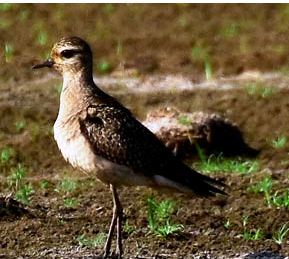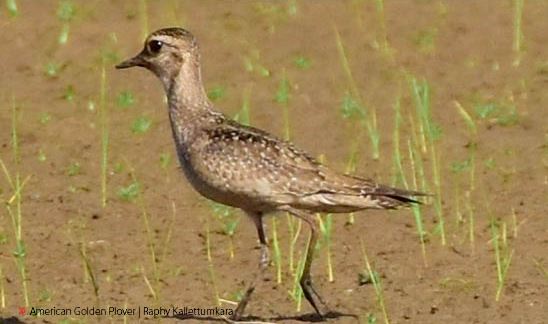Thommana Kole is a part of the Thrissur Kole wetlands which is one among the three Ramsar sites in Kerala. This is the largest freshwater system on the western coast of India spreading over the districts of Thrissur and Malappuram, from Uppungal in Malappuram district to Thommana-Muriyad Kole at the northern side of Chalakudy River. It consists of marshes and both man-made and natural channels which are fed directly by two rivers Kecheri and Kurumaly and indirectly by Chalakudy River, all originating from the Western Ghats. The Kole wetland is rich in bio-diversity. Thommana consists of a large water channel bordered by two bund roads running in an east-west direction. The wetland is utilized by the local community for paddy cultivation and also for fishing. For almost half a year, the paddy fields are waterlogged. This wetland is abundant in bird life and as it is very near to my home, I am a regular visitor.
On 19 January 2017, I started bird watching at Thommana, as usual at 7 am. The location was immediately north to the Chalakudy – Moonupedika Road which bifurcates the Thommana Kole into Southern and Northern portions and was not prepared for cultivation but was marshy and covered with grass. At about 8.30 am, when I was about to finish the bird watching session, I came across a group of Pacific Golden Plovers Pluvialis fulva. One bird among this group had some distinctions in plumage and behaviour from others. I got interested and spent nearly half an hour in taking pictures of this bird at various angles. The unusual behaviour and plumage reasonably compelled me to think that this bird was an odd one in the group and may be an altogether different species. Though I immediately shared the pictures with several other birders, they initially did not find it as very different from Pacific Golden Plover. I uploaded one picture in eBird along with the checklist and deleted some pictures of the bird from my hard disc and keeping only a few for record.
The south west monsoon of 2019 was very heavy in Kerala, making it difficult to do any bird watching trips for several days on end. To utilise these days usefully I decided to go through my photograph collection accumulated over the years. Thus after a period of two years, I again came across the photograph of this Golden Plover taken on 19 January 2017. Its wings were long, with primaries extending beyond the tail tip. Comparing with the pictures and evaluating with the information available in the internet, I was able to zero in on this bird as an American Golden Plover Pluvialis dominica. But, the American Golden Plover had not been reported or recorded before in any of the South Asian countries including India, causing me to be really wary in arriving at a conclusion on the identity of the bird. So I posted the photograph of this bird in the Facebook group of Ask IDS of Indian Birds with a request for identity confirmation (https://www.facebook.com/photo.php?fbid=2355220874513929&set=gm.1499295426875825&type=3&theater&ifg=1). In a marathon discussion that followed, the identity of the bird was confirmed to be that of the American Golden Plover.
Detailed Analysis

It is well-documented that there is a wide-overlap between the morphometrics and plumages of American Golden Plover and Pacific Golden Plover. Johnson & Johnson (2004) found only two characteristics in non-breeding plumage that can be used to separate these two species – (1) The number of primaries exposed beyond the longest tertial (2-3 in Pacific, 4-5 in American) and (2) primary projection past the end of the tail (estimated at 0-9mm in Pacific, 12-22mm in American). Hybrids between these two species, though rare, have been reported (Withrow & Winker, 2014). However, in this case – despite the bird not being captured – there is an increasing concurrence of characteristics that indicated this bird to be an Americal Golden Plover rather than Pacific. To start with, the bird under discussion is in juvenile plumage with crisp, uniform pattern and is extremely grey-toned throughout lacking any golden or yellowish in plumage element which is congruent with American but very rare in Pacific. Tertials, all fully grown but with juvenile pattern, are very short, is falling far short of the tail tip which is another strong character for American. Primary extension beyond the tail is much longer than any typical Pacific and falls well within the range of a typical American. At least four visible primary tips project beyond the tertials (2-3 in Pacific) and this is quite a strong American character. Hence, in every respect this looks like an American and to be Pacific, it would have to be atypical in multiple ways, each of which is actually more suggestive of an American (Chris Kehoe, in litt.). Chris has served previously in British Ornithological Union Records Committee (BOURC) and is familiar with both species.
Alvaro Jaramillo, a former member of the California Bird Records Committee (CBRC) concurred with the ID as an American Golden Plover based on structure and plumage tones. Another former member of CBRC, Mike Rogers, former Secretary of CBRC (1999), indicated that this bird is really long-winged, with long primary projection both past the tertials and past the tail tip for any Pacific and most juvenile Pacific would be much more golden/yellow on this date. Additionally, Killian Mullarney who served in Irish Rare Birds Committee (IRBC), felt this bird is absolutely perfect for an American Golden and agreed with the opinions of the other experts mentioned above.
Hence, there is a unanimous vote from serving and ex-members of bird records committees towards an American Golden that there is little reticence to accept this bird as the first record for south Asia.
Status
Though American Golden Plover is essentially a new world species, there have been a number of incidences of vagrancy outside its main wintering range (Johnson et al., 2019, Wiersma et al., 2019). These are believed to be the result of breeding-ground sympatry and occasional association with the “wrong flock,” such as American Golden-Plovers from western end of range migrating with Pacific Golden-Plovers. Nearest records are from Turkey (Kirwan, 1994), Israel (Harrison, 2013), Oman (Grieve et al., 2005) and Hong Kong (Brazil, 2009).
This would be the 528th species for the state of Kerala (Chandran & Praveen, 2019) and 1318th species (Praveen et al., 2019) for India as a country.
Acknowledgements
I express my gratitude to Andrew Paul Baily and Chris Kehoe for the identity confirmation. I am also grateful to Vivek Tiwari who sent the photographs to California Bird Records Committee (CBRC) and some other American rare birds committees for confirmation. I also thank Abdulla Paleri, Chithrabhanu Pakaravoor, Abhilash Raveendran, Sandeep Das and Dileep Chandran for their support and to P. B. Samkumar for translating and helping me in the preparation of this article.
References
- Brazil, M. (2009). Field Guide to the Birds of East Asia: Eastern China, Taiwan, Korea, Japan and Eastern Russia. Christopher Helm, London
- Chandran, A., & J. Praveen. (2019). Kerala state bird checklist: additions during 2015 – May 2019. Journal of Threatened Taxa, 11(7): 13941–13946. https://doi.org/10.11609/jott.4904.11.7.13941-13946
- Grieve, A., Hill, B. J. N., Lassey, P. A., & Wallace, D. I. M. (2005). The first American Golden Plover Pluvialis dominica in Oman and Arabia. Sandgrouse, 27(1): 75–77.
- Harrison, I. (2013). From the Rarities Committees. Sandgrouse, 35(1): 82–86.
- Johnson, O. W., & Johnson, P. M. (2004). Biometrics and field identification of Pacific and American Golden Plovers. Brit. Birds, 97(9): 434–443.
- Johnson, O. W., P. G. Connors, & P. Pyle. (2019). American Golden-Plover (Pluvialis dominica), version 3.1. In The Birds of North America (P. G. Rodewald, Editor). Cornell Lab of Ornithology, Ithaca, NY, USA. https://doi.org/10.2173/bna.amgplo.03.1
- Kirwan, G. M. (1994). American Golden Plover, Pluvialis dominica, in Turkey. Zool. Middle East, 10: 23–26.
- Praveen J., Jayapal, R., & Pittie, A. (2019). Checklist of the birds of India (v3.0). Website: http://www.indianbirds.in/india/ [Date of publication: 05 May, 2019].
- Wiersma, P., Kirwan, G. M. & Boesman, P. (2019). American Golden Plover (Pluvialis dominica). In: del Hoyo, J., Elliott, A., Sargatal, J., Christie, D. A. & de Juana, E. (eds.). Handbook of the Birds of the World Alive. Lynx Edicions, Barcelona. (retrieved from https://www.hbw.com/node/53819 on 19 October 2019)
- Withrow, J. J., & K. Winker. (2014). Genetics of a high-latitude cryptic speciation event: American and Pacific Golden-Plovers. Wilson Journal of Ornithology, 126: 429–442.
